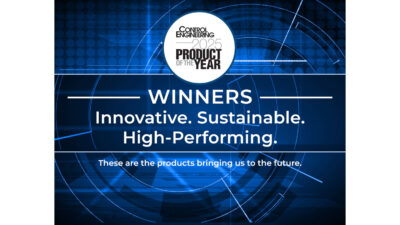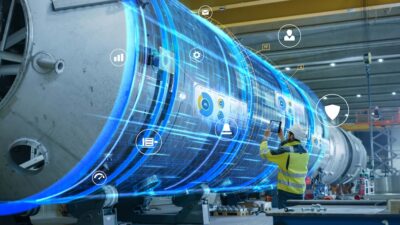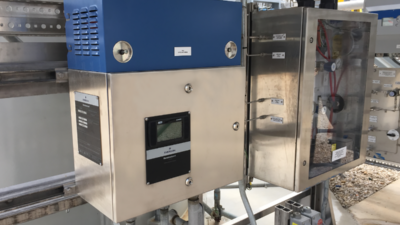Green power proponents are looking ahead to a time when the world runs on hydrogen, with our energy needs supplied by this simple and hugely abundant substance. Cars will run on it leaving only water vapor as exhaust. Every home will have its own fuel cell power plant. Dirty, centralized coal-burning boilers with their greenhouse gases will disappear in favor of distributed cogeneration technol...
Sidebars: Tutorial: How fuel cells work
Green power proponents are looking ahead to a time when the world runs on hydrogen, with our energy needs supplied by this simple and hugely abundant substance. Cars will run on it leaving only water vapor as exhaust. Every home will have its own fuel cell power plant. Dirty, centralized coal-burning boilers with their greenhouse gases will disappear in favor of distributed cogeneration technology. Science fiction? At the moment, yes, but stationary industrial fuel cells are gaining a foothold. Fuel cell technologies small and large require embedded instrumentation and power controls; applications include battery replacement, uninterruptible power supplies (UPS), and ac or dc power supplies. Is an on-site plant in your future?
A fuel cell is an electrochemical device with similarities to a battery, but one that can be chemically refueled and generate current as long as the fuel supply continues. Hydrogen remains the primary fuel for several main technologies (see sidebar). Hydrogen or other fuel gas and atmospheric oxygen go in, chemically creating electric current with heat and water vapor as exhaust. Carbon dioxide emissions can result depending on the fuel supply, but there is no combustion at all in the normal sense. The dc electrical output has to be electronically inverted into ac for connection to the grid and regular industrial consumption. Units typically include an internal buffer, such as a bank of ultra-capacitors, to assist with abrupt changes in demand. Users report that the output is “computer grade” with very little electrical noise.
A fuel cell’s ability to extract useful energy from fuel is higher than any combustion process, particularly when the waste heat can be captured and used. Efficiencies in large stationary units can reach 60% for electric generation alone and 85% with combined heat and power (CHP). This compares to 35% for a subcritical coal-fired boiler and 50% for a natural gas combined-cycle plant. Fuel cells are also scalable, so they don’t have to be large to enjoy efficiencies, and distributed generation will be entirely practical.
PEM (which stands both for polymer electrolyte membrane and proton exchange membrane) is the most common design for automotive fuel cells and runs on pure hydrogen plus available air. While these cells are efficient (60%), compact, start up quickly, and operate at relatively low temperatures, they are expensive and need a pure fuel supply. Modified PEM units, which can run on methanol, show promise for small electronic devices. PEM units are usually small (&10 kW), and stationary applications center around backup power for computer systems.
PAFC (phosphoric acid fuel cell) designs use liquid phosphoric acid contained in a Teflon-bonded silicon carbide matrix as an electrolyte. The electrodes are porous carbon laced with platinum catalyst. While their fuel is pure hydrogen, they can tolerate the presence of carbon oxides, which allows them to use reformed fossil fuels, typically natural gas. This is a mature design and dates back to the earliest commercial installations. Its low efficiency (40%) for electric generation is mitigated by useful heat output.
MCFC (molten carbonate fuel cell) designs use a molten carbonate salt mixture (lithium, sodium, and potassium) suspended in an inert ceramic lithium aluminum oxide matrix. Since they run at high temperatures, they do not need precious metals for catalysts in their electrodes, nor do they need an external reformer stage. Both of these reduce overall unit cost. MCFC units can reach 60% efficiency for electric generation alone.
SOFC (solid oxide fuel cell) designs use a hard, non-porous ceramic compound of zirconium oxide with small amounts of yttrium. Their very high operating temperatures eliminate the need for precious metals catalysts or external reformers, however they need a very long warm-up cycle when first starting up. While generally still considered experimental, SOFC units can reach 60% efficiency for electric generation alone.
The problem for fuel cells is initial cost. From an operational standpoint, a fuel cell wins easily over other co-generation technologies, but including the capital cost tilts the balance to conventional approaches. With today’s designs, the lifecycle cost of a fuel cell is much higher based on current natural gas pricing. The total lifecycle cost of a phosphoric acid fuel cell (PAFC) is $0.18-20 per kWh, and a molten carbonate fuel cell (MCFC) closer to $0.15-17 due to a simpler design and higher efficiency. To compare, a microturbine costs $0.14 per kWh and a gas-fired engine and generator is $0.10-12. Installations so far are either being done for demonstration purposes or subsidized to overcome the high capital costs. David Paul, marketing manager for UTC Power, expects the balance to shift. “Fuel cells have significant advantages over conventional systems, including their low noise, low vibration, and ultra-low emissions profile,” he says. “UTC Power’s next-generation design now in active development will have a lifecycle cost that is half that of the current 200 kW model.”
Even with high capital costs, the fuel cell market is, relatively speaking, booming. According to Fuel Cell Today, an industry monitoring group, 2006 was a record year with more than 18 MW of new capacity installed world-wide (counting stationary units generating greater than 10 kW each). Roughly half the total installed base of 100+ MW is in North America. To put this in context, a single, medium-sized, coal-fired plant is around 600 MW, so stationary fuel cells are still a very small slice of the electrical generation pie.
Where should they be used?
One of the biggest advantages of fuel cells is reliability. With a dependable supply of the right fuel, units have achieved availability exceeding 99%. Applications where an uninterrupted power supply is paramount find the technology very attractive, such as telephone switching, critical computer networking infrastructure, and similar areas. At the same time, bear in mind that large fuel cells do not start at the flip of a switch. Ramping up from full shut down can take several hours to days, so where they’re needed, they usually run continuously. Moreover, since cost justification depends on operating efficiency, fuel cells are typically base loaded to take full advantage of their low generating cost.
Applications where the waste heat can be put to work adds to cost effectiveness. Food processors, breweries, hotels, hospitals, and other applications that need large supplies of hot water or steam can capture the heat. Even office and commercial buildings can channel heat into absorption chillers for air conditioning in the summer or simply for heat in the winter.
Installations with a cheap or free supply of fuel can benefit. Some chlorate processes generate hydrogen as a byproduct. More commonly there are sources of ADG (anaerobic digester gas, which is mostly methane) from wastewater treatment plants, agricultural waste, dairy processing, landfill gas, breweries, and others. ADG can be processed and fed into a fuel cell. This has the additional benefit of turning a pollutant into an energy source, since methane is many times more potent than carbon dioxide as a greenhouse gas. Pig farms and sewage treatment plants could become the next major source of electricity if practical methods to capture the gas can be installed.
Some states and nations are pushing fuel cell technology as an answer to energy shortages. Connecticut has a program to install 100 MW of generating capacity using renewable fuel sources by 2008. That will undoubtedly involve fuel cells in addition to solar and wind power. California, Korea, and Japan also have aggressive programs employing fuel cells to use alternative fuels and reduce greenhouse gasses. These will support manufacturers as they seek to increase volume and cut costs.
Different technologies, different fuels
There are three main technologies used for large stationary fuel cells. While other approaches are more attractive for powering your car or recharging your laptop, they aren’t as efficient for distributed power generation. (See sidebar.)
PAFCs have been around the longest and are adaptable for stationary and large vehicle use. They typically run on pure hydrogen, which can be reformed from natural gas or ADG using a separate reforming stage. They operate at the lowest temperature of the group, 150-200 °C, which is a mixed blessing. Low temperatures make them faster to start up, but require expensive platinum catalysts, and their cooler exhaust is less useful for co-generation than waste heat from MCFCs or solid oxide fuel cells (SOFCs). While they have the lowest efficiency for straight electrical generation, if waste heat can be used effectively, they have similar combined heat and power (CHP) efficiency to the others.
MCFCs have taken the lead for new installations, largely because of their omnivorous appetite for fuels, including coal gases and carbon oxides. They run at high temperatures (600-700 °C), so they need no expensive catalysts and can reform fuels internally. Their main drawback has been durability because of high operating temperatures and corrosive electrolytes. New materials and ongoing research are improving stack life significantly.
SOFCs are used the least, but have been growing in popularity. They run hottest of all at 1,000 °C, so require extensive thermal shielding and will have few applications outside stationary uses. Their electrolyte is a solid porous ceramic that can tolerate high temperature and requires no precious-metal catalysts. SOFC units can also reform fuels internally and are the most tolerant of sulfur, so there are high expectations for their use with coal-derived fuels.
Real installations
Verizon Communications has created its “central office of the future” in Garden City, Long Island, combining fuel cells, engine-generator sets, waste heat capture, and utility supplied power. Central offices house critical electronic switching and backup power equipment for Verizon’s wireline communications. The equipment uses a great deal of power and creates much heat that has to be dissipated. Cooling and air handling systems consume even more energy. The Garden City office is a prototype to evaluate new technologies in search of greater efficiency and cost savings. The 292,000 sq ft building typically uses 2.7 MW provided by on-site technologies and the local grid. Natural gas-supplied fuel cells were built by UTC Power using PAFC technology and produce 200 kW each. At the time of its installation, at 1.4 MW, Garden City was the world’s largest fuel cell plant. Eric Breen, president of Marine Interface, the system designer, recalls, “the project really resulted from the big 2003 blackout. After that, Verizon was looking to have the utmost reliability of all telecom carriers.”
Sierra Nevada Brewing Co. installed a 1 MW fuel cell power plant last summer using natural gas supplied MCFCs built by FuelCell Energy. This unit is sufficient for normal requirements and even transfers power to the grid. Originally it used only natural gas, but now can also operate on ADG scavenged from an internal wastewater treatment process, providing 25-40% of required fuel. This simple process provides cheap methane and eliminates it as a potential pollutant. “By converting the fuel cell plants to operate on ADG, we have further advanced our company’s sustainability goals and reduced our energy and waste disposal costs,” says Sierra Nevada’s Ken Grossman. Moreover, the thermal output of the fuel cells is used to create process steam that would otherwise come from natural gas-fired boilers.
Future economics
It’s clear that fuel cells have proven themselves in operation. The only remaining question is economic viability. The initial cost of new units will undoubtedly decline as manufacturers develop better designs, materials, and manufacturing techniques. It’s also a safe bet that fuel prices will increase. Both trends will improve the attractiveness of fuel cell technology. While automotive applications may lag due to hydrogen distribution and logistics issues, the ability for larger stationary units to consume a wider variety of fuels—from coal to biogas—makes them much more attractive in the short term.
The industry is also resilient at this stage. Normally segments undergoing development shake out weaker competitors and consolidate better performers, but so far a variety of companies are carving out niches.
Bruce Ludemann, SVP sales & marketing for FuelCell Energy, believes costs will continue to decline. “As we continue to improve the technology, we will also take cost out of it,” he says. “It’s simple: the cost goes down, the volume goes up, and we become more competitive.”
UTC Power, who dates back to the Apollo moon missions, is committed to its plan. “The company believes strongly in the future of this technology and its development,” says Paul. “We’re optimistic about growth not only in the stationary market, but also transportation. We’re staffing up and excited about our future.”
ONLINE
www.apc.com
www.controleng.com/archive October 2006 cover story
www.eere.energy.gov
www.fce.com
www.fctec.com
www.fuelcelltoday.com
www.maxwell.com
www.powergeneration.siemens.com
www.utcfuelcells.com
Additional Reading
Power Monitoring
Author Information
Peter Welander is process industries editor. Reach him at [email protected] .
Tutorial: How fuel cells work
The construction of a fuel cell is similar to a battery, with an anode and cathode separated by an electrolyte. Units require temperature sensors, controllers, actuation (valves), networks or other means of communications and typically connect to a power management system. In operation, fuel is consumed but not the electrolyte. The cell’s chemical composition determines efficiency, operating temperature, and fuel requirements.
Source: Control Engineering with information from U.S. Department of Energy.



